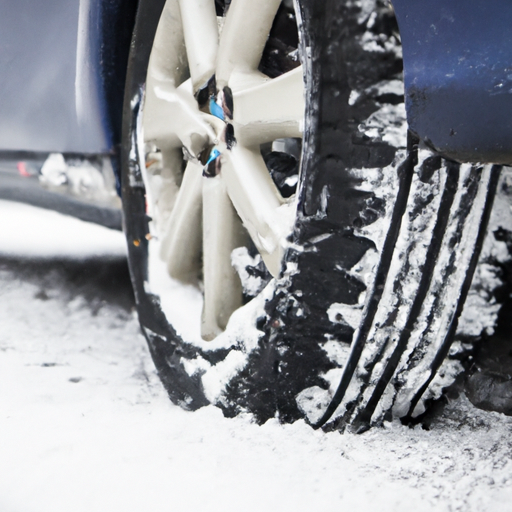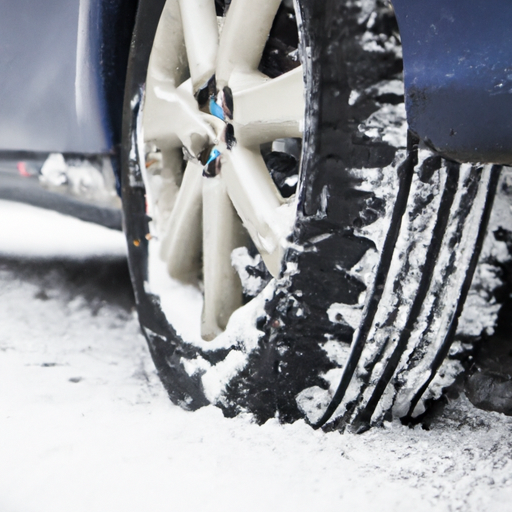If you live in a region that experiences mild winters, you may have found yourself wondering if winter tires are really necessary. After all, it may seem like an unnecessary expense and hassle for a few months of slightly colder weather. In this article, we will explore the importance of winter tires in mild winter regions and shed light on why investing in these specialized tires can greatly enhance your safety and driving experience during the colder months.
1. Understanding Winter Tires
1.1 What are winter tires?
Winter tires, also known as snow tires, are specifically designed to provide improved traction and performance in cold weather conditions, especially on snow and ice-covered roads. They are made with a unique rubber compound that remains flexible in freezing temperatures, allowing for better grip on the road. Winter tires also have deeper tread patterns and more sipes (thin slits) in the tread blocks, which help to enhance traction and channel away snow and slush.
1.2 How do winter tires differ from all-season tires?
While all-season tires are designed to provide a balance of performance in different weather conditions, winter tires are optimized for cold weather and winter driving. The key differences lie in their composition and tread design. Winter tires have softer rubber compounds that stay pliable in freezing temperatures, while all-season tires tend to harden, reducing their grip. Winter tires also feature deeper tread patterns and specialized sipes that provide more traction on slippery surfaces, whereas all-season tires have shallower tread depths and less aggressive tread patterns.
1.3 The key components of winter tires
Winter tires are composed of several key components that contribute to their enhanced performance in winter conditions. The tread compound, as mentioned earlier, is made of softer rubber that remains flexible in cold temperatures. The tread pattern consists of wider and deeper channels, designed to disperse snow, slush, and water from beneath the tire, reducing the risk of hydroplaning. The tread blocks also have numerous sipes, which provide extra biting edges and increase traction on icy surfaces.
1.4 Benefits of using winter tires
Using winter tires in regions with mild winters still offers numerous benefits. First and foremost, they significantly improve traction and stability on cold roads, even when there is minimal snowfall. Winter tires also enhance grip in wet and slushy conditions, reducing the chances of accidents due to skidding or sliding. Additionally, they improve braking performance, allowing you to stop more effectively on icy or slippery surfaces. The handling and control benefits of winter tires also instill a sense of confidence, even in unexpected weather changes.
1.5 Drawbacks of using winter tires
Although winter tires provide significant advantages in cold weather conditions, there are a few drawbacks to consider. One of the main concerns is the cost, as winter tires can be more expensive than all-season tires. Additionally, winter tires tend to wear out faster when used on dry roads, potentially requiring replacement sooner than expected. Changing tires twice a year can also be a hassle for some individuals. However, the long-term safety benefits often outweigh these drawbacks.
2. Characteristics of Regions with Mild Winters
2.1 Definition of a mild winter
Regions with mild winters experience relatively moderate or temperate weather conditions during the winter season. While these areas may still have some colder temperatures and occasional snowfall, the severity and duration of winter conditions are generally less pronounced compared to regions with harsh winters. Mild winter regions often have milder daytime temperatures, less frequent snow or ice accumulation, and shorter durations of freezing conditions.
2.2 Climatic conditions in regions with mild winters
In regions with mild winters, the climate tends to be characterized by milder temperatures, with freezing conditions occurring less frequently. These areas may experience intermittent snowfall, but it often melts quickly due to higher average temperatures. Precipitation during the winter season in mild regions can include rain, sleet, and occasional snow, with the majority of winter precipitation occurring in liquid form rather than solid ice or snow.
2.3 Snowfall and precipitation levels
While regions with mild winters may not experience heavy snowfall or prolonged snow cover, it is still possible to encounter occasional snow or icy conditions. The amount of snowfall varies depending on the specific location and climate patterns. In some mild winter regions, snowfall may be limited to a few inches per year or even less, while in others, it may be slightly more substantial. Additionally, precipitation levels can influence the presence of slush, which can create slippery conditions on the road.
2.4 Possible presence of black ice
Even in regions with mild winters, the presence of black ice is a potential hazard. Black ice refers to a transparent layer of ice that forms on road surfaces, often appearing as a thin and glossy sheen. Black ice is notoriously difficult to detect, as it blends in with the color of the road, making it highly dangerous for drivers. Although mild winter regions may experience less frequent occurrences of black ice, it is still advisable to take precautions and consider the use of winter tires for improved traction.
2.5 Temperature fluctuations
Regions with mild winters may still experience temperature fluctuations, with occasional drops below freezing. These fluctuations can create unpredictable driving conditions, especially in the early morning or late evening when temperatures are at their lowest. It is important to note that even a slight drop in temperature can significantly affect the road surface, causing it to become icy or slippery. Winter tires can help mitigate the risks associated with temperature fluctuations by providing better grip and traction.

3. Understanding Tire Traction
3.1 The importance of tire traction
Tire traction refers to the ability of a tire to grip and maintain traction with the road surface. It plays a critical role in ensuring safe and controlled driving, particularly in adverse weather conditions. Proper traction allows tires to effectively transfer the engine’s power to the road, enabling acceleration, braking, and cornering. Without sufficient traction, a vehicle’s handling, stability, and braking performance can be compromised, leading to an increased risk of accidents.
3.2 Factors affecting tire traction
Several factors can influence tire traction, including tread design, tire composition, road conditions, and temperature. The tread design, which varies between tire types, plays a crucial role in gripping the road surface. The composition of the tire, including the rubber compound used, affects its ability to remain flexible and maintain grip in different weather conditions. Road conditions, such as wet or icy surfaces, influence the overall traction available to the tire. Temperature also plays a significant role, as colder temperatures can affect the rubber’s performance and decrease traction.
3.3 Winter tires and their enhanced traction
Winter tires are specifically designed to provide enhanced traction in cold weather conditions. Their unique tread patterns, deeper channels, and sipes increase the number of biting edges that make contact with the road, improving grip on snow, slush, and ice. The softer rubber compound used in winter tires enables them to retain flexibility, ensuring better traction even at freezing temperatures. The combination of these factors significantly enhances the tire’s ability to maintain traction and deliver consistent performance in winter conditions.
3.4 The potential risks of reduced traction
When tires have reduced traction, the risks associated with driving in winter conditions increase. Reduced traction can lead to skidding, sliding, or losing control of the vehicle. Braking distances are also significantly longer with reduced traction, increasing the chances of accidents. Additionally, reduced traction can impact a vehicle’s stability and handling, making it more prone to unexpected movements or loss of control. Overall, the importance of maintaining adequate traction cannot be overstated when it comes to safe winter driving.
4. The Role of Winter Tires in Mild Winters
4.1 Increased safety on cold roads
Even in regions with mild winters, the use of winter tires can significantly increase safety on cold roads. While these regions may not experience heavy snowfall, they are still susceptible to low temperatures and occasional icy conditions. Winter tires provide improved traction and grip on cold roads, reducing the risk of skidding or sliding. This increased safety benefit is crucial, particularly in areas where unexpected freezing temperatures or black ice can occur.
4.2 Enhanced grip in wet and slushy conditions
In mild winter regions, wet and slushy conditions are more common than heavy snowfall. Winter tires excel in these conditions, thanks to their specialized tread design and softer rubber compounds. The deeper channels and sipes help to expel water and slush from beneath the tires, allowing for better contact with the road surface. The enhanced grip provided by winter tires significantly reduces the chances of hydroplaning or losing control in wet or slushy conditions.
4.3 Improvements in braking performance
Winter tires play a crucial role in improving braking performance in mild winter conditions. When temperatures drop, the braking distance of a vehicle increases. Winter tires, with their superior traction capabilities, help to minimize this increase in braking distance. They provide better grip on cold surfaces, allowing for more effective stopping power in critical situations. By reducing the time it takes to come to a stop, winter tires contribute significantly to overall safety on the road.
4.4 Handling and control benefits
The handling and control benefits offered by winter tires are not limited to regions with harsh winters. Even in mild winter regions, the unpredictable weather conditions and occasional drop in temperatures can significantly affect a vehicle’s handling. Winter tires provide enhanced grip and traction, allowing for better maneuverability and improved control. Whether navigating through a curve or encountering a slippery road, the enhanced handling benefits provided by winter tires instill confidence and peace of mind.
4.5 Confidence during unexpected weather changes
Mild winter regions are known for their unpredictable weather patterns, including sudden temperature drops and unexpected changes in precipitation. Winter tires can greatly enhance your confidence and preparedness during these weather changes. With their superior traction capabilities, winter tires ensure that you are ready to face any unexpected hazards on the road. Whether it’s a sudden snowfall or a drop in temperature creating icy patches, winter tires provide peace of mind and a safer driving experience.

5. Alternative Options for Mild Winters
5.1 All-season tires in mild winter conditions
In regions with mild winters, an alternative option to winter tires is the use of all-season tires. All-season tires are designed to provide a balance of performance in various weather conditions, including mild winter driving. While they may not offer the same level of traction and grip as winter tires, all-season tires can still provide adequate performance in regions with less severe winter conditions. It is important to note, however, that their performance may be compromised in icy or snow-covered conditions.
5.2 Tire chains or studs as temporary solutions
For occasional winter driving in mild winter regions, tire chains or studs can be considered as temporary solutions. Tire chains provide additional traction by gripping the road surface, while studded tires have metal studs that bite into ice or packed snow, enhancing grip. However, it is important to research and follow local regulations regarding the use of tire chains or studs, as some regions may have restrictions or outright bans on their use. Additionally, tire chains and studs can cause damage to road surfaces and should only be used when necessary.
5.3 Performance tires for mild winter driving
Performance tires, often associated with warm weather driving or sports cars, can also be an option for mild winter regions. Some performance tires are designed to maintain decent traction in mild winter conditions. These tires typically have a tread pattern that balances performance and grip, allowing for better handling and control in both dry and wet conditions. However, it is important to consider their limitations and consult with tire experts to determine if they are suitable for the specific weather conditions in your region.
5.4 Additional accessories to improve traction
In addition to tires, there are various accessories available that can improve traction in mild winter conditions. Traction control systems, electronic stability control, and anti-lock braking systems are examples of vehicle features that can enhance traction and improve overall safety. Snow socks or textile tire covers are also available as temporary solutions to provide extra grip when faced with snowy or icy conditions. These accessories can be used as supplements to enhance traction, but they should not be relied upon as a substitute for proper tires in severe winter conditions.
6. Factors to Consider
6.1 Individual driving habits and conditions
When deciding whether winter tires are necessary in mild winter regions, it is important to consider your individual driving habits and conditions. Factors such as the frequency and length of your driving trips, the areas you typically drive in, and your tolerance for potential risks should be taken into account. If you frequently encounter colder temperatures, occasional snow or ice, or are in an area prone to black ice, winter tires may provide added safety and peace of mind.
6.2 Cost and budget considerations
The cost of winter tires should also be considered when making the decision. Winter tires tend to be more expensive than all-season tires, and it is essential to budget accordingly. However, it is important to remember that the cost of accidents or damage resulting from inadequate traction can far exceed the cost of winter tires. Additionally, the longevity of winter tires can be extended by using them strictly during the winter season, reducing the overall cost in the long run.
6.3 Local regulations and requirements
Local regulations and requirements regarding the use of winter tires should always be taken into consideration. Some regions have specific laws that mandate the use of winter tires or certain tread depths during winter months, regardless of the severity of the winter conditions. Familiarize yourself with the local regulations to ensure compliance and avoid potential fines or penalties. Even if not legally required, winter tires may still be the safest option for driving in mild winter regions.
6.4 Long-term benefits and cost savings
The long-term benefits and cost savings associated with using winter tires in mild winter regions should also be considered. By improving safety and reducing the risk of accidents, winter tires can potentially save you from costly repairs or medical expenses resulting from collisions. Additionally, using winter tires during the winter season can extend the lifespan of your all-season tires, allowing them to wear more evenly and last longer. Investing in winter tires can be seen as a long-term investment in your safety and the overall performance of your vehicle.

7. Expert Opinions
7.1 Insights from tire manufacturers
Tire manufacturers consistently recommend the use of winter tires in regions with mild winters. They emphasize the importance of traction and the significant safety benefits provided by winter tires, even in less severe winter conditions. According to tire experts, the unique tread design and specialized rubber compounds of winter tires outperform all-season tires in cold weather, reducing the occurrence of accidents and providing peace of mind to drivers.
7.2 Recommendations from automotive experts
Automotive experts echo the sentiments of tire manufacturers, emphasizing the importance of winter tires in mild winter regions. They state that the enhanced traction, improved braking performance, and better handling benefits of winter tires make them a worthwhile investment. Automotive experts believe that winter tires are not solely for regions with heavy snowfall, but for any area that experiences colder temperatures and occasional adverse winter conditions.
7.3 Testimonials from drivers in mild winter regions
Testimonials from drivers in mild winter regions have consistently praised the use of winter tires. Many drivers have reported feeling safer and more confident on the road, even in conditions where snowfall is minimal or infrequent. They have shared stories of avoiding accidents, maintaining control during unexpected weather changes, and having peace of mind while driving in colder temperatures. These experiences highlight the tangible benefits of using winter tires in regions with mild winters.
8. Case Studies
8.1 Comparison of accident data between winter tire users and non-users
Various case studies have compared accident data between drivers using winter tires and those without. In these studies, it was consistently found that drivers using winter tires experienced fewer accidents and had a lower risk of collision-related injuries. The improved traction and control provided by winter tires played a significant role in preventing accidents and minimizing the severity of collisions. These case studies provide empirical evidence of the safety benefits associated with using winter tires, even in mild winter regions.
8.2 Real-life experiences of drivers without winter tires
Drivers who have chosen not to use winter tires in mild winter regions have also shared their experiences. While some may argue that all-season tires or alternative options are sufficient, real-life accounts often highlight the challenges and risks encountered without winter tires. Stories of skidding, loss of control, and near-miss accidents serve as reminders of the potential consequences of not using appropriate tires in winter conditions. These experiences reinforce the importance of making informed decisions regarding tire choice.
8.3 Success stories of drivers using winter tires in mild winter conditions
Conversely, success stories from drivers who have chosen to use winter tires in mild winter regions provide further evidence of their effectiveness. These drivers have shared tales of safely navigating through icy patches, coming to controlled stops on slippery roads, and feeling confident in unpredictable weather changes. The success stories of winter tire users demonstrate that even in regions with mild winters, the use of winter tires can significantly contribute to a safer and more enjoyable driving experience.

9. Guidance for Decision Making
9.1 Assessing the severity of the mild winter
When deciding whether winter tires are necessary in mild winter regions, it is essential to assess the severity of the winter conditions. Consider factors such as temperature fluctuations, precipitation levels, presence of black ice, and the frequency of inclement weather events. This assessment will help determine the potential risks and the need for enhanced traction and grip provided by winter tires.
9.2 Evaluating personal risk tolerance
Personal risk tolerance is an important factor in decision making. Determine how comfortable you are with the potential risks associated with driving in mild winter conditions. If you prioritize safety and want to minimize the chances of accidents, winter tires are highly recommended. However, if you have a higher risk tolerance and are confident in your abilities to handle adverse conditions, alternatives may be considered.
9.3 Consulting tire experts and professionals
Consulting with tire experts and professionals can provide valuable insight when deciding on the right tires for mild winter driving. They can assess your specific driving needs, review the climate and road conditions of your region, and provide expert advice on tire selection. Tire professionals can also offer guidance on performance options or additional accessories that may enhance traction in mild winter conditions.
9.4 Considering local recommendations and experiences
Lastly, consider local recommendations from authorities and fellow drivers who have experience in mild winter regions. Local knowledge is often invaluable when making decisions related to winter driving. Pay attention to any recommendations from local government bodies or transportation departments. Additionally, seek insights from friends, neighbors, or fellow drivers who have firsthand experience with the specific weather conditions in your area.
10. Conclusion
In conclusion, while winter tires may not be deemed necessary in regions with mild winters, they offer significant advantages in terms of safety, traction, and overall peace of mind. The enhanced grip, improved braking performance, and handling benefits provided by winter tires can greatly reduce the risk of accidents and ensure a safer driving experience, even in regions with less severe winter conditions. By carefully considering individual factors, budget considerations, and expert opinions, you can make an informed decision regarding the use of winter tires in mild winter regions.


